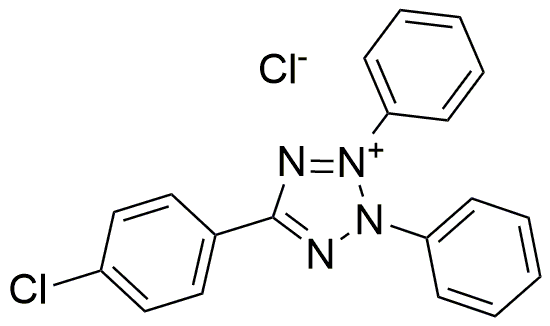2,3-Diphenyl-5-(4-chlorophenyl)tetrazolium chloride is widely utilized in research focused on:
- Cell Viability Assays: This compound is commonly used in laboratories to assess cell viability and proliferation. It helps researchers determine the effects of various treatments on cell health, making it essential in drug development and cancer research.
- Histological Staining: In histology, it serves as a vital stain for identifying living cells in tissue samples. This application is crucial for pathologists and researchers studying tissue morphology and disease progression.
- Electrochemical Sensors: The compound is employed in the development of electrochemical sensors for detecting biological molecules. This application is beneficial in medical diagnostics and environmental monitoring.
- Biochemical Research: It is used in biochemical assays to study enzyme activity and metabolic processes. This aids researchers in understanding cellular functions and developing therapeutic strategies.
- Pharmaceutical Formulations: The compound can be incorporated into pharmaceutical formulations to enhance drug delivery systems, improving the efficacy of medications and patient outcomes.
Información general
Propiedades
Seguridad y normativas
Aplicaciones
2,3-Diphenyl-5-(4-chlorophenyl)tetrazolium chloride is widely utilized in research focused on:
- Cell Viability Assays: This compound is commonly used in laboratories to assess cell viability and proliferation. It helps researchers determine the effects of various treatments on cell health, making it essential in drug development and cancer research.
- Histological Staining: In histology, it serves as a vital stain for identifying living cells in tissue samples. This application is crucial for pathologists and researchers studying tissue morphology and disease progression.
- Electrochemical Sensors: The compound is employed in the development of electrochemical sensors for detecting biological molecules. This application is beneficial in medical diagnostics and environmental monitoring.
- Biochemical Research: It is used in biochemical assays to study enzyme activity and metabolic processes. This aids researchers in understanding cellular functions and developing therapeutic strategies.
- Pharmaceutical Formulations: The compound can be incorporated into pharmaceutical formulations to enhance drug delivery systems, improving the efficacy of medications and patient outcomes.
Documentos
Hojas de datos de seguridad (HDS)
La SDS proporciona información de seguridad completa sobre la manipulación, el almacenamiento y la eliminación del producto.
Especificación del producto (PS)
La PS proporciona un desglose completo de las propiedades del producto, incluida la composición química, el estado físico, la pureza y los requisitos de almacenamiento. También detalla los rangos de calidad aceptables y las aplicaciones previstas del producto.
Certificados de análisis (COA)
Busque certificados de análisis (COA) ingresando el número de lote del producto. Los números de lote y de partida se pueden encontrar en la etiqueta de un producto después de las palabras "Lote" o "Lote".
Número de catálogo
Número de lote/lote
Certificados de origen (COO)
Este certificado de origen confirma el país en el que se fabricó el producto y también detalla los materiales y componentes utilizados en él y si se deriva de fuentes naturales, sintéticas u otras fuentes específicas. Este certificado puede ser necesario para cumplir con las normativas aduaneras, comerciales y regulatorias.
Número de catálogo
Número de lote/lote
Hojas de datos de seguridad (HDS)
La SDS proporciona información de seguridad completa sobre la manipulación, el almacenamiento y la eliminación del producto.
DownloadEspecificación del producto (PS)
La PS proporciona un desglose completo de las propiedades del producto, incluida la composición química, el estado físico, la pureza y los requisitos de almacenamiento. También detalla los rangos de calidad aceptables y las aplicaciones previstas del producto.
DownloadCertificados de análisis (COA)
Busque certificados de análisis (COA) ingresando el número de lote del producto. Los números de lote y de partida se pueden encontrar en la etiqueta de un producto después de las palabras "Lote" o "Lote".
Número de catálogo
Número de lote/lote
Certificados de origen (COO)
Este certificado de origen confirma el país en el que se fabricó el producto y también detalla los materiales y componentes utilizados en él y si se deriva de fuentes naturales, sintéticas u otras fuentes específicas. Este certificado puede ser necesario para cumplir con las normativas aduaneras, comerciales y regulatorias.


